Libyan history
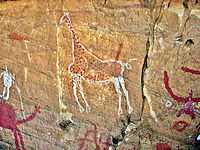
"Archaeological evidence indicates that the coastal plain of ancient Libya was inhabited by Neolithic peoples from as early as 8000 BC [10,000 b2k]."[1]
"[T]he Ancient Libyans were skilled in the domestication of cattle and the cultivation of crops.[2]"[1]
History
Libya
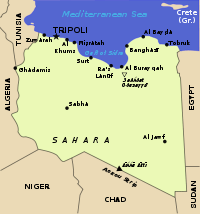
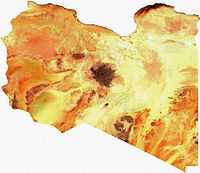
The vector, geographical map that approximately locates the political nation of Libya relative to other political nations such as Egypt, Sudan, Niger, Algeria, and Tunisia, and to physical geography features like the Mediterranean Sea is shown at the right.
At the left is a satellite image of the Earth's surface that corresponds currently with the political nation of Libya.
Geography
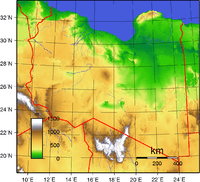
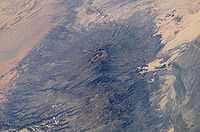
The Tibesti Mountains, specifically Emi Koussi, is at 18°33'6"N 19°47'36"E.
Geology
"The onset of the 5.9 kiloyear event's intense aridification resulted in the "green Sahara" rapidly transforming into the Sahara Desert as it is today."[1]
Oligocene
The Oligocene dates from 33.9 ± 0.1 x 106 to 23.03 x 106 b2k.
"The presence of taxa as distinctive as Prohylobates, Proconsul and Rangwapithecus in the African early Miocene indicates that the cercopithecoid–hominoid diversification initiated during the Oligocene".[3]
Miocene
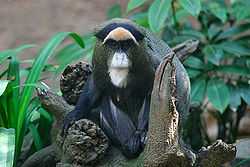
The Miocene dates from 23.03 x 106 to 5.332 x 106 b2k.
Fossil cercopithecoids have been found in the Early Miocene of eastern Libya. Cercopithecoids are primates and from the parvordo Catarrhini as are humans, differing in superfamily: Cercopithecoidea versus Hominoidea.
Zaltanpithecus occurred in eastern Libya.[4]
Prohylobates is from the Early Miocene of Libya.[5]
"Before the late Miocene, the published cercopithecoid record has largely been limited to rare and incomplete materials of Prohylobates and Zaltanpithecus collected from the early–middle Miocene of northern Africa".[3]
Prehistory
The prehistory period dates from around 7 x 106 b2k to about 7,000 b2k.
Paleolithic
The paleolithic period dates from around 2.6 x 106 b2k to the end of the Pleistocene around 12,000 b2k.
"Because of fossil and tool discoveries, there is proof that some representatives of Homo erectus for the first time about 2 million years ago ... over Northwest Africa south of Spain.[6]"[7]
"Around 600,000 years ago, there was probably a second wave [of Homo erectus].[8]"[7]
"About 200,000 years ago, early or archaic anatomically modern humans [evolved] from Homo erectus.[9]"[7]
"It was the Sahara, in contrast to the coastal strip and oases, was only habitable when sufficient rainfall would allow sufficient flora and fauna.[10]"[7]
In the image at the right are apparent stone tools from the current sandy deserts of North Africa. On the left is a worked stone of 440 mm in length that comes from Libyan Erg Tamiset (latitude N25.25, longitude E10.52). On the right is a worked stone of 345 mm in length from Erg Murzuq in the Libyan southwest (N24.29/E11.59). The middle worked stone of 360 mm is a hand ax native to south Algeria, from the Erg Tiffemine (N26.29)/E06.49).
Holocene
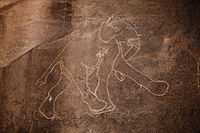
The Holocene starts at ~11,700 b2k and extends to the present.
"The Holocene is a geological epoch which began at the end of the Pleistocene[11] (around 12,000 14C years ago) and continues to the present. The Holocene is part of the Quaternary period. ... The period follows the last glacial period (regionally known as the Wisconsinan Glacial Period, the Baltic-Scandinavian Ice Age, or the Weichsel glacial)."[12]
"Various populations of pastoralists have left paintings of abundant wildlife, domesticated animals, chariots, and a complex culture that dates back to at least 10,000 BCE [12,000 b2k] in Northern Niger and neighboring parts of Algeria and Libya."[13]
Neolithic
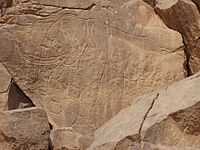
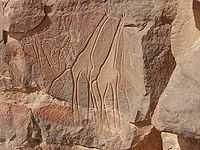
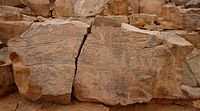

"The Neolithic Subpluvial began during the 7th millennium BC and was strong for about 2,000 years; it waned over time and ended after the 5.9 kiloyear event (3900 BCE) [5900 b2k]."[14]
At the right is an image of an engraving of an elephant at Wadi Mathendous in southwest Libya. This engraving may date from the Neolithic Subpluvial.
Giraffes are shown in the engraving on the left.
The spear point or arrow point at the lower right from Algeria needs more descriptive information.
The image at the lower left shows petroglyphs of animals, including a crocodile, on rocks from Wadi Mathendous near Germa, Fezzan, southwestern Libya.
The lowest image on the left shows cave art exhibited at the Germa Museum, possibly from Wadi Mathendous.
Acacus mountains


"Rock paintings and carvings at Wadi Mathendous and the mountainous region of Jebel Acacus are the best sources of information about prehistoric Libya, and the pastoralist culture that settled there. The paintings reveal that the Libyan Sahara contained rivers, grassy plateaus and an abundance of wildlife such as giraffes, elephants and crocodiles.[15]"[1]
"Fossilized bones show that by the sixth millennium B.C. (or about 7,000 years ago), cattle, sheep and goats roamed over green savanna, and rock art [at left] depicts cows with full udders. The occasional image even shows milking"[16].
Ancient history
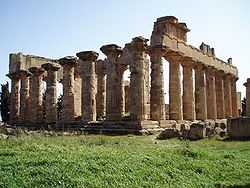
The ancient history period dates from around 8,000 to 3,000 b2k.
"There are in Greek literature some very similar versions according to which Cronus [Saturn], of course during his universal reign, ruled over the western world or especially over Libya, Sicily and Italy."[17]
"Although Cyrene was later incorporated into the Roman Empire, it was originally founded in 630 BC as a colony of the Greeks from the Greek island of Thera. 16 kilometers from Cyrene is the port of Apollonia (Marsa Sousa). The city promptly became the chief town of ancient Libya and established commercial relations with all the Greek cities, reaching the height of its prosperity under its own kings in the 5th century BC. Soon after 460 BC, it became a republic, and after the death of Alexander III of Macedon (323 BC) it was passed to the Ptolemaic dynasty."[18]
Early history
The early history period dates from around 3,000 to 2,000 b2k.
In its early history, Libya may have been considered to be all of Africa west of Egypt.
"Sataspes went down to Egypt, and there got a ship and crew, with which he set sail for the Pillars of Hercules. Having passed the Straits, he doubled the Libyan headland, known as Cape Soloeis, and proceeded southward. Following this course for many months over a vast stretch of sea, and finding that more water than he had crossed still lay ever before him, he put about, and came back to Egypt. Thence proceeding to the court, he made report to Xerxes, that at the farthest point to which he had reached, the coast was occupied by a dwarfish race, who wore a dress made from the palm tree. These people, whenever he landed, left their towns and fled away to the mountains; his men, however, did them no wrong, only entering into their cities and taking some of their cattle. The reason why he had not sailed quite round Libya was, he said, because the ship stopped, and would no go any further."[19]
"These be the Libyan tribes whereof I am able to give the names; and most of these cared little then, and indeed care little now, for the king of the Medes. One thing more also I can add concerning this region, namely, that, so far as our knowledge reaches, four nations, and no more, inhabit it; and two of these nations are indigenous, while two are not. The two indigenous are the Libyans and Ethiopians, who dwell respectively in the north and the south of Libya. The Phoenicians and the Greek are in-comers."[19]
"Ten days' journey from Augila there is again a salt-hill and a spring; palms of the fruitful kind grow here abundantly, as they do also at the other salt-hills. This region is inhabited by a nation called the Garamantians, a very powerful people, who cover the salt with mould, and then sow their crops. From thence is the shortest road to the Lutophagi, a journey of thirty days. In the Garamantian country are found the oxen which, as they graze, walk backwards. This they do because their horns curve outwards in front of their heads, so that it is not possible for them when grazing to move forwards, since in that case their horns would become fixed in the ground. Only herein do they differ from other oxen, and further in the thickness and hardness of their hides. The Garamantians have four-horse chariots, in which they chase the Troglodyte Ethiopians, who of all the nations whereof any account has reached our ears are by far the swiftest of foot. The Troglodytes feed on serpents, lizards, and other similar reptiles. Their language is unlike that of any other people; it sounds like the screeching of bats."[19]
Original research
- See also: Original research inquiry and Research
Hypothesis:
- Libyan history with respect to hominins should go back to at least 106 b2k.
- See also: Control groups and Proof of concept
See also
- African history
- Classical planets
References
- 1 2 3 4 "Libya, In: Wikipedia". San Francisco, California: Wikimedia Foundation, Inc. June 24, 2012. Retrieved 2012-06-25.
- ↑ Federal Research Division of the Library of Congress, (1987), "Early History of Libya", U.S. Library of Congress. Retrieved 11 July 2006.
- 1 2 Nancy J. Stevens, Erik R. Seiffert, Patrick M. O’Connor, Eric M. Roberts, Mark D. Schmitz, Cornelia Krause, Eric Gorscak, Sifa Ngasala, Tobin L. Hieronymus & Joseph Temu (30 May 2013). "Palaeontological evidence for an Oligocene divergence between Old World monkeys and apes". Nature 497 (7451): 611-4. doi:10.1038/nature12161. http://www.indiaenvironmentportal.org.in/files/file/fossil.pdf. Retrieved 2014-06-12.
- ↑ B. R. Benefit (2008). Geol. East Libya 3: 247–66.
- ↑ E. Delson (1979). "Prohylobates (Primates) from the Early Miocene of Libya: A new species and its implications for cercopithecid origins". Geobios 12: 725–33.
- ↑ Friedemann Schrenk, Stephanie Müller: Die Neandertaler, C. H. Beck, München 2005, S. 42.
- 1 2 3 4 "Geschichte Libyens, In: Deutsch Wikipedia". San Francisco, California: Wikimedia Foundation, Inc. Juni 4, 2013. Retrieved 2013-06-29.
- ↑ Carl Zimmer: Woher kommen wir? Die Ursprünge des Menschen. Spektrum Akademischer Verlag, 2006, S. 90.
- ↑ John G. Fleagle, Zelalem Assefa, Francis H. Brown und John J. Shea (2008). "Paleoanthropology of the Kibish Formation, southern Ethiopia: Introduction". Journal of Human Evolution 55 (3): 360-5,. doi:10.1016/j.jhevol.2008.05.007.
- ↑ Kathryn Ann Bard, Steven Blake Shubert (Hgg.): Encyclopedia of the Archaeology of Ancient Egypt, Psychology Press, 1999, S. 6.
- ↑ "International Stratigraphic Chart". International Commission on Stratigraphy. Retrieved 2009-12-23.
- ↑ "Holocene, In: Wikipedia". San Francisco, California: Wikimedia Foundation, Inc. June 13, 2012. Retrieved 2012-06-25.
- ↑ "Prehistoric North Africa, In: Wikipedia". San Francisco, California: Wikimedia Foundation, Inc. March 2, 2012. Retrieved 2012-06-25.
- ↑ "Neolithic Subpluvial, In: Wikipedia". San Francisco, California: Wikimedia Foundation, Inc. April 18, 2013. Retrieved 2013-06-30.
- ↑ Roland Oliver (1999), The African Experience: From Olduvai Gorge to the 21st Century (Series: History of Civilization), London: Phoenix Press, revised edition, pg 39.
- ↑ Stephanie Pappas (June 20, 2012). "Got milk? Research finds evidence of dairy farming 7,000 years ago in Sahara.". The Christian Science Monitor. Retrieved 2012-06-25.
- ↑ MW Schiebe (1986). "The Saturn of the "Aeneid"-Tradition or Innovation?". Vergilius (1959-) 32: 43-60. doi:10.2307/41591939. http://www.jstor.org/stable/10.2307/41591939. Retrieved 2013-06-29.
- ↑ "Tourism in Libya, In: Wikipedia". San Francisco, California: Wikimedia Foundation, Inc. May 8, 2013. Retrieved 2013-06-29.
- 1 2 3
External links
- African Journals Online
- Bing Advanced search
- Google Books
- Google scholar Advanced Scholar Search
- JSTOR
- Bunson, Margaret. "Libya." Encyclopedia of Ancient Egypt. New York: Facts on File, Inc., 1991
- Lycos search
- NASA's National Space Science Data Center
- NCBI All Databases Search
- Office of Scientific & Technical Information
- PsycNET
- Questia - The Online Library of Books and Journals
- SAGE journals online
- The SAO/NASA Astrophysics Data System
- Scirus for scientific information only advanced search
- SpringerLink
- Taylor & Francis Online
- What Happened to the Ancient Libyans?, Chasing Sources across the Sahara from Herodotus to Ibn Khaldun by Richard L. Smith.
- Who Lived in Africa before the Roman Conquest?
- Wiley Online Library Advanced Search
- Yahoo Advanced Web Search
| |||||||||||||||||||||||||||||||||||||||||||||||||||||
![]() This is a research project at http://en.wikiversity.org
This is a research project at http://en.wikiversity.org
| |
Educational level: this is a research resource. |
| |
Resource type: this resource is an article. |
| |
Resource type: this resource contains a lecture or lecture notes. |
| |
Subject classification: this is an Anthropology resource. |
| |
Subject classification: this is an archaeology resource. |
| |
Subject classification: this is a geography resource . |
| |
Subject classification: this is a history resource . |